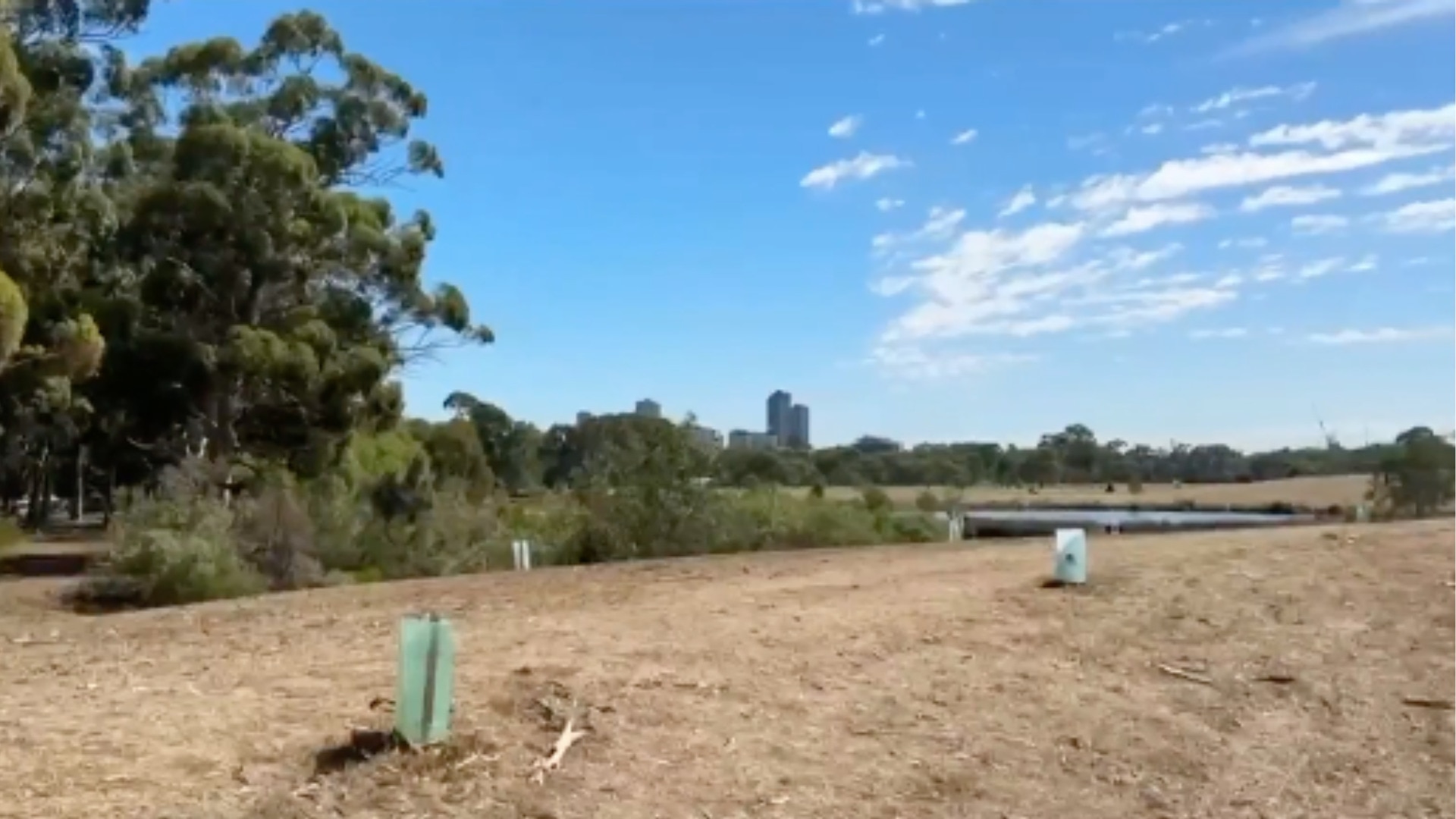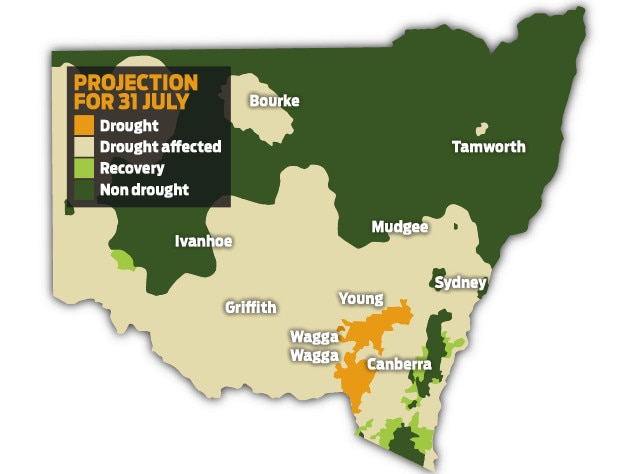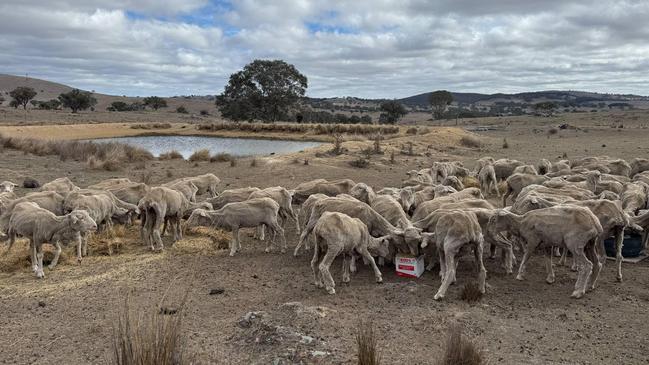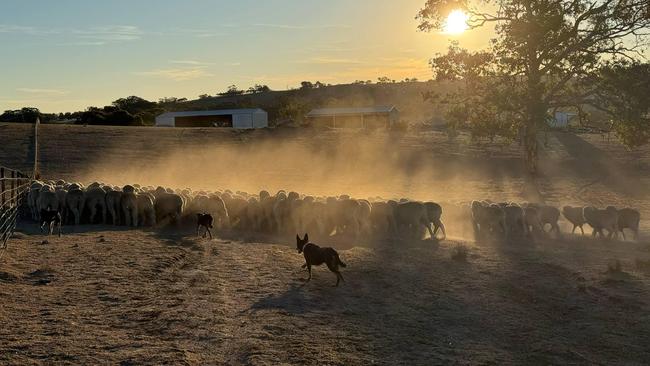May rainfall a drop in the bucket for drought-struck NSW farmers
As the Mid-North Coast reels in the wake of devastating floods, a crippling drought has taken hold in the south, turning thriving properties into barren dustbowls.

NSW
Don't miss out on the headlines from NSW. Followed categories will be added to My News.
Coastal NSW remains waterlogged in the aftermath of devastating flooding but farming families hundreds of kilometres inland are praying for rain, with drought conditions set to intensify in the heart of the bush.
While the Mid North Coast was hit by record-breaking falls last week, almost a quarter of NSW is classified as being “drought-affected”, with more than half of the state predicted to fall into that category by the end of winter, according to the NSW Department of Primary Industries (DPI).
The DPI drought indicator map, updated this week, shows 19.3 per cent of the state is drought affected while 1.8 per cent is officially in drought, with the dry spell worst in the Murray and Riverina regions.

Although some areas received spurts of rainfall from the east coast low that caused so much destruction up north last week, inland residents are concerned their region isn’t out of the woods.
While the rain last week paused Yass Valley Council’s plans to implement water restrictions, Mayor Jasmin Jones said the region’s farmers were facing down a “green drought”, where “topsoil receives moisture and a bit of greenery comes through but there isn’t any meaningful growth”.

“The rain is a blessing, it’s welcome, but 90 per cent of our farmers will be hand-feeding all winter,” Ms Jones said.
“The rain has brought its own problems too – dams still aren’t full, but they’re really boggy around the edges and farmers can lose sheep when they wander into those areas.”
Among those affected is Bec Murray, a fourth-generation sheep and cattle station owner who received only 25mm of rain over four months before a downpour of 80mm last week.
But Ms Murray said the top-up would mean little without more consistent rainfall, with her young family facing the prospect of selling off stock to pay to truck in water and feed.
“While the rain is certainly a welcome sight, we still need to continue feeding the livestock to ensure their survival,” Ms Murray said.
“The newly sprouted greenery will help, but as temperatures drop, the ground will start to chill, hindering any growth
“It’s a bit of a double-edged sword: we’re grateful for the rain, but the sudden cold is taking a toll on the animals.
“Many people remain largely unaware of the conditions we’re facing.”

Ms Murray said the family would dig their heels in and hope more rain was on its way.
“Our two oldest boys are both incredibly eager to take over when Stephen and I decide to retire,” she said.
“They have vivid memories of the dry and dusty conditions during the drought, (but) their love for the land runs deep … they are committed to doing whatever it takes to take care of it.”
Senior Bureau of Meteorology climatologist Hugh McDowell said most parts of the Riverina-Murray were still severely deprived of water despite the recent downfall.
“While we’ve seen some rainfall, it certainly hasn’t been crazy. Areas out west, along the border with Victoria, are actually still seeing average-to-below-average rainfall for the month of May,” Mr McDowell said.
“Large parts of the Riverina are still seeing below-average rain … so while long-term deficiencies may have been eased, I don’t think it’s gone the full way.
“It’s welcome rainfall but probably not enough.”

Senior meteorologist Joran Notara said high-pressure systems were prone to form over inland Australia, creating a barrier for the wet weather systems that are pushed onto the east coast by coastal troughs and offshore winds.
DPI drought predictions show that up to half the state could be drought-affected by midwinter, with the entire Murray and Riverina regions impacted, and large swathes of the Central West, Central Tablelands as well as NSW’s Western and South East tipped to be dry by July 31.
Starving creatures and dust-swept paddocks are still fresh in the memory of Boree Creek sheep farmer Andrew Green, who has co-owned and operated Aloeburn Pastoral, near Wagga Wagga, with his wife Jodie for the past 14 years.
“In the ’19-’20 drought, we still had dams that were full. We’ve gone into this dry period and there’s no water at all,” Mr Green said.

“All of our surface water, dam water and creek water dried up very quickly through January and February … we got a bit of rain this last week, but 30ml isn’t really drought-breaking.
“It doesn’t matter how many times you go through it, it’s still really difficult – you’re dealing with live animals and you’re seeing them go through the stress of these environmental conditions … it’s tough.”
While farmers in the region have done their best to learn from previous droughts and prepare themselves for worst-case scenarios, Mr Green says they can only have so much control over increasingly erratic climate conditions.
“As business owners we do things pretty well, but we work in an industry where we rely on the environment and Mother Nature.
“As good as we think we are, Mother Nature has different ideas … (her) plan is pretty hard to keep track of.”

NSW Farmers Grains Committee chair Justin Everitt urged officials to stay alive to the “silent disaster” should the dry conditions continue.
“Farmers with too little rain are thinking of those who’ve had far too much – we’re truly all living through the absolute extremes,” Mr Everitt said.
“(Drought) is a slow, drawn-out process of deterioration that can go on for years with no end date in sight.
“We’re used to being prepared for anything and everything that nature throws our way, but when we’re dealing with disasters of this scale, we need our governments to back us with the right support so we can stay on our feet through these events, and beyond.”
FARMERS PARCHED FOR RELIEF FUNDING
A special state government fund created to help drought-stricken farmers has had barely 30 applications since it was created 18 months ago.
The state Opposition has blamed the low take-up on high interest rates and shorter time frames on repayments, even as farmers across parts of the state brace for a bone-dry winter.
NSW Nationals leader Dugald Saunders, who visited Wagga Wagga in the state’s rapidly drying south last week, claimed Labor’s Drought Ready and Resilient fund was “not up to scratch”.

“While the north of the state is under water right now, farmers in the south are really struggling through extremely dry conditions,” he said.
“The price of feed is going through the roof and there’s very little water around, forcing some to sell off stock and others to seriously consider how they are going to survive, yet there’s no plan from this government to prepare for or deal with the situation.”
The Opposition compared its Farm Innovation Fund – which offered loans on a 2.5 per cent interest rate of up to $1 million over 20 years – to Labor’s Drought Ready and Resilient Fund, which comes with 4.6 per cent five-year loans, or 5.3 per cent 10-year loans, of up to $250,000.
Budget estimates earlier this year revealed, however, just 34 applications have been made through the Ready and Resilient fund since its creation in 2023, with $6,234,294 paid out from it as of February 28.
Agriculture Minister Tara Moriarty fired back at the Opposition questioning the effectiveness of the fund, saying it was one of multiple drought-proofing and relief programs created out of the Opposition’s Farm Innovation Fund.
She said the Coalition’s fund had been split into two – the Drought Ready and Resilient Fund and the Drought Infrastructure Fund, made to help drought-proof businesses on the land.
“Since the government established two special drought funds in late 2023, farmers have received more than $148.9 million in funding,” Ms Moriarty said.
“To better deal with drought, the government repurposed the Farm Innovation Fund so it would refocus on drought support and established the Drought Infrastructure Fund.
“At the same time our government introduced the Drought Ready and Resilient Fund to offer farmers for the first time access to funds to use for operations during a drought, and after a drought, which the Drought Infrastructure Fund wasn’t as aligned to.”
It’s understood the change in interest rates reflects changing market conditions.
Ms Moriarty said worsening drought conditions had already led to a spike in applications, with 186 farmers applying.
“It is concerning to see these prolonged dry conditions,” she said. “We will continue monitoring the situation and not rule out any required assistance response.”
Do you have a story for The Daily Telegraph? Message 0481 056 618 or email tips@dailytelegraph.com.au
Originally published as May rainfall a drop in the bucket for drought-struck NSW farmers


